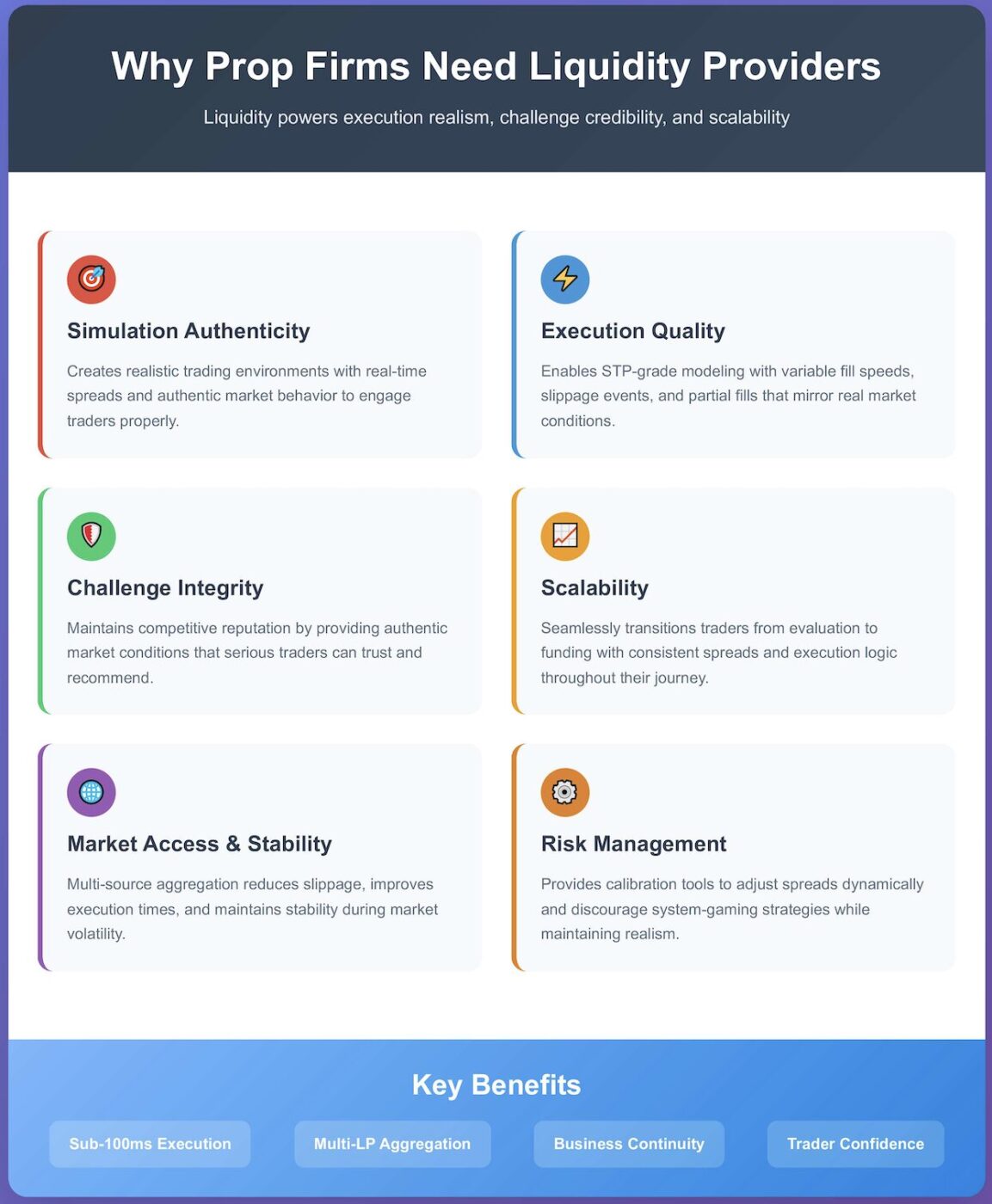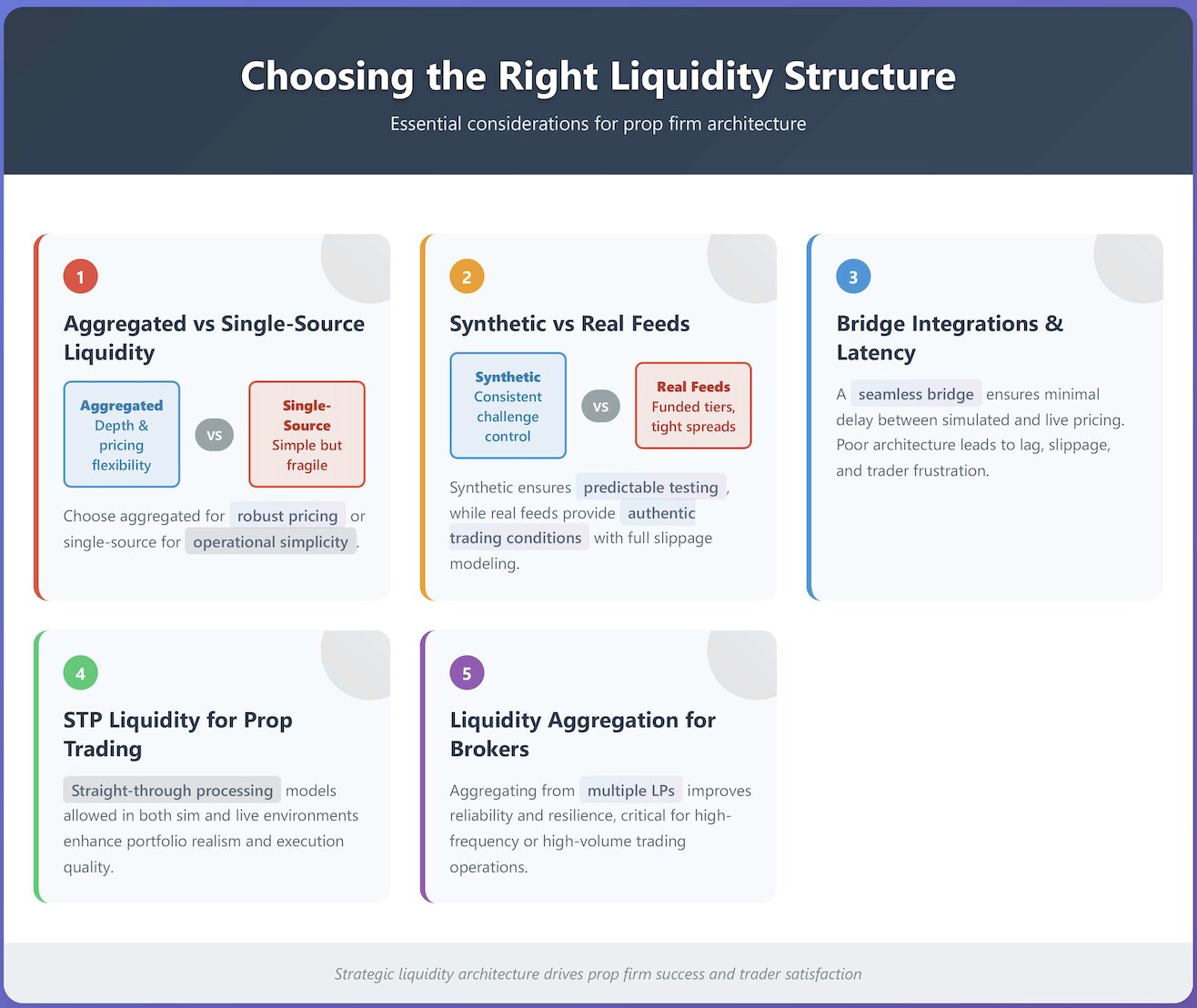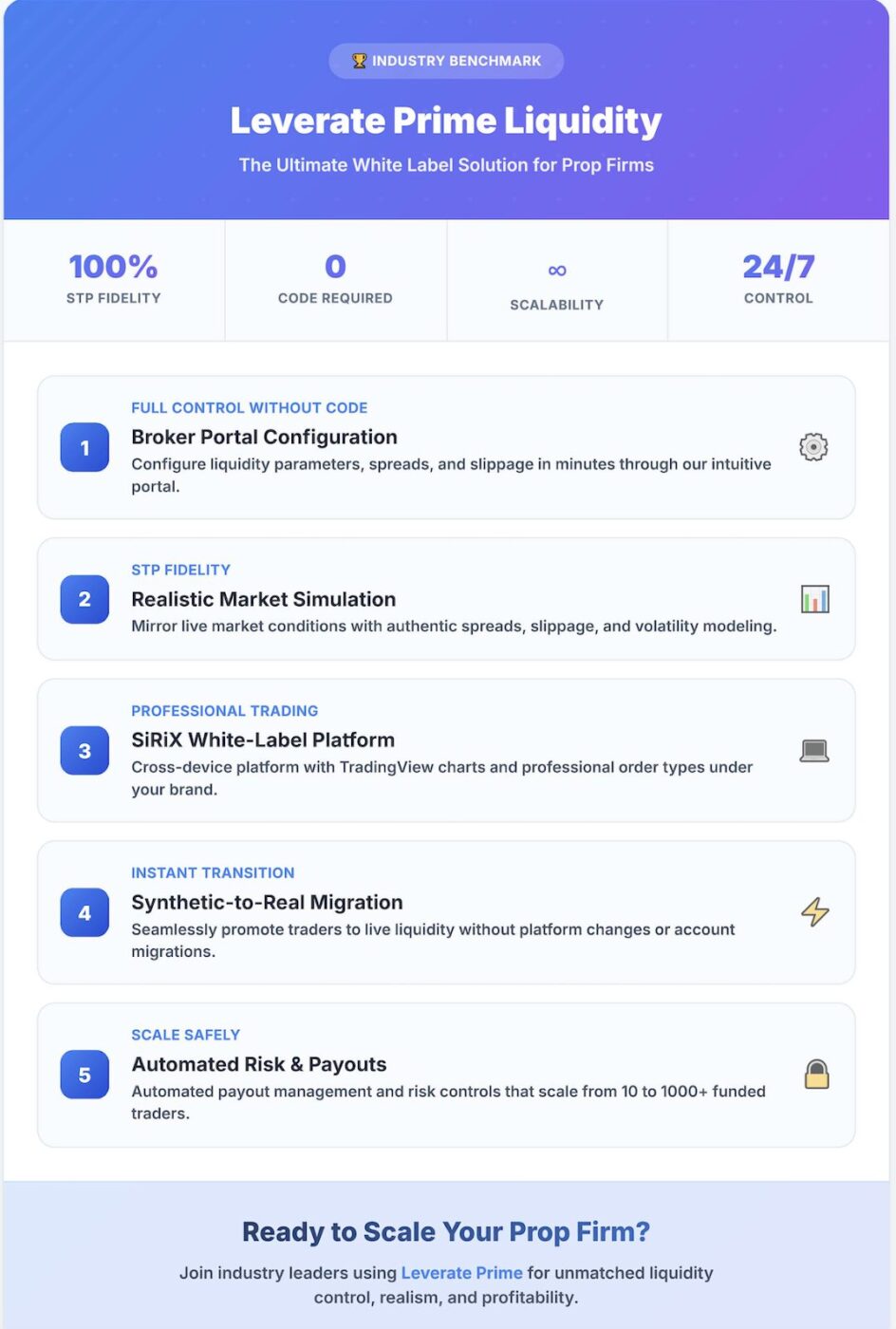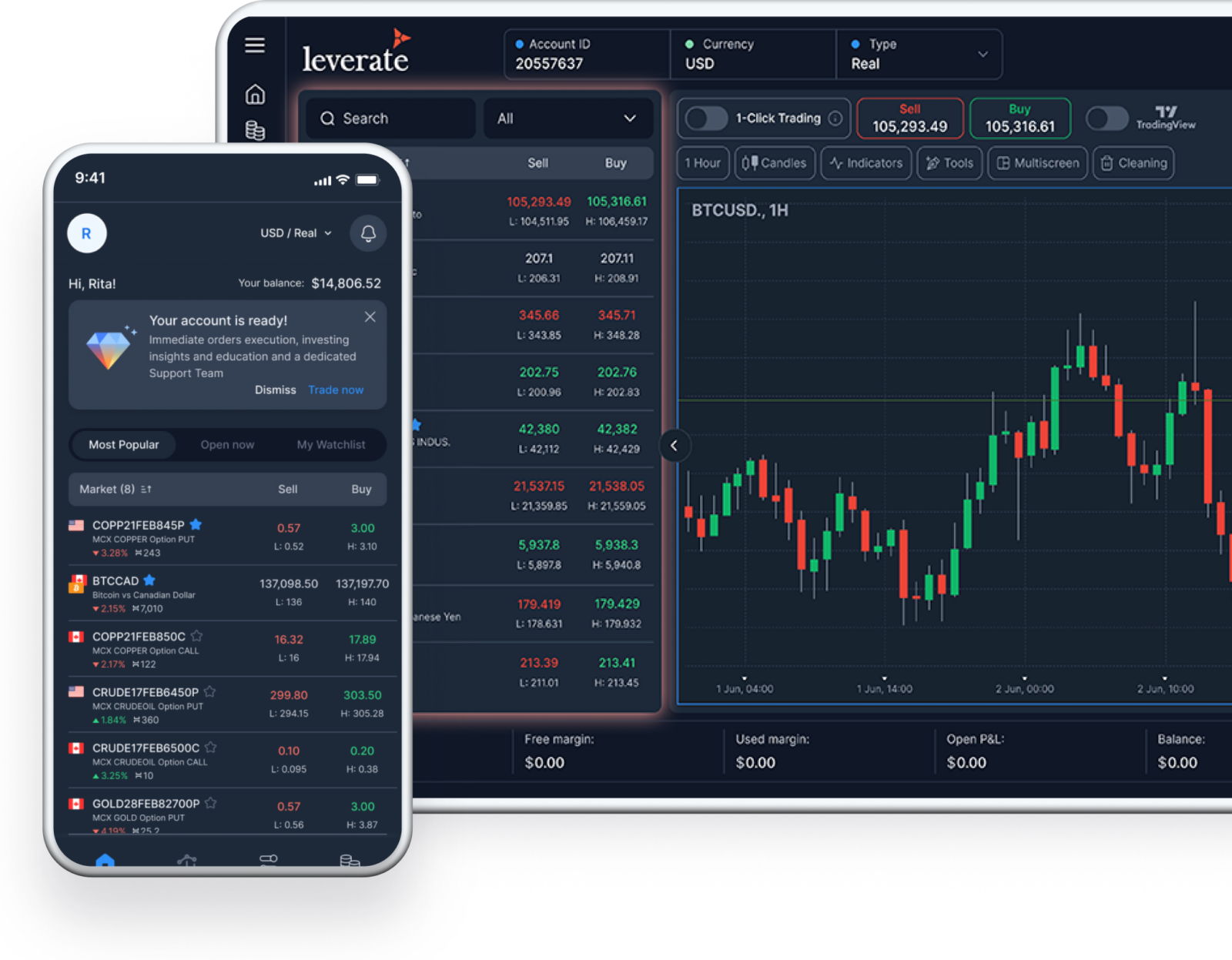
Liquidity for Prop Firms: How It Works and Why It Matters
TL;DR
Liquidity for prop firms is a critical but often overlooked foundation for realistic trader challenges, smooth execution, and scalable growth. This article defines liquidity in prop trading, addresses six common myths, and explains how Leverate’s white-label liquidity solution, incorporating the SiRiX trading platform, Broker Portal, and real-data feeds, enables seamless transitions from synthetic to real liquidity, thereby enhancing trader confidence and operational integrity.
Introduction
Liquidity for prop firms is more than a technical consideration; it’s the backbone of execution quality, trader experience, and brand credibility. Whether orders truly route to live markets or remain in a simulated environment, liquidity for prop firms directly influences everything from challenge fairness to funded trader retention. Yet, many setups downplay or misunderstand its importance, creating risks in credibility and scalability. This article tackles that head-on: we’ll explore what liquidity means in prop contexts, dispel widespread myths, map liquidity structures, and show how Leverate Prime’s liquidity solution delivers realistic environments with full control.
What Is Liquidity in the Context of Prop Trading?
Liquidity, in financial markets, refers to how easily an asset can be bought or sold without significantly affecting its price. For prop firms, liquidity takes on layered meaning:
- Execution realism: Even in simulated environments, smooth order handling builds trader trust.
- Spread credibility: Chase fixed or fake spreads, and savvy traders will detect the difference.
- Internal vs. external routing: Some trades execute within firm infrastructure (“synthetic liquidity”), others tap external liquidity pools (“real liquidity”).
- Execution speed vs. market depth: Both are crucial. Speed ensures responsive filling; depth avoids slippage when traders size up.
Why Prop Firms Still Need Liquidity Providers
Even though prop firms don’t operate like traditional brokerages, where trades are routed to the live market, liquidity remains the critical mechanism that powers execution realism, challenges credibility, and scalability.
The misconception that “demo-only” environments don’t require liquidity overlooks the role it plays in simulating market dynamics. The absence of authentic liquidity results in unrealistic fills, fixed spreads, and market behavior that traders will immediately identify as artificial, damaging trust and reducing challenge completions.
Here’s why every serious prop firm needs a robust liquidity framework:
1. Simulation Authenticity: The Core of Trader Engagement
Prop traders join challenges expecting to be tested under conditions that prepare them for live markets. Real-time spreads, variable volatility, and authentic depth-of-market simulation give traders the sense they are in a legitimate trading environment. Without these, challenges risk becoming practice accounts rather than performance benchmarks.
2. Execution Quality: STP-Grade Modeling for Realism
Liquidity providers enable Straight-Through Processing (STP)-grade execution modeling, which accurately reflects:
- Variable fill speeds under different market conditions.
- Slippage events during high-volatility periods.
- Partial fills for large orders when market depth is thin.
This realism not only improves trader preparation but also ensures the firm can evaluate participants on performance that translates to real-world trading.
3. Challenge Integrity and Market Credibility
Every serious trader forum reviews and discusses prop firm fairness. A firm using static demo feeds risks being exposed for unrealistic trading conditions.
Authentic liquidity mitigates:
- Price spikes that don’t reflect actual market moves.
- Fixed spreads in volatile events that traders identify as artificial.
- Discrepancies between chart data and order execution.
Firms that integrate true market conditions maintain a competitive reputation, attract better traders, and increase word-of-mouth recruitment.
4. Scalability from Evaluation to Funding
Liquidity is also the key to smoothly scaling funded traders. Without it, moving a trader from evaluation to live conditions is like changing the rules mid-game. With Leverate Prime’s aggregated liquidity, the same spreads, volatility, and execution logic can be maintained throughout the trader journey, minimizing adaptation issues and protecting performance metrics.
5. Market Access, Stability, and Latency Management
Leverate’s liquidity network connects to multiple LPs, ECNs, and aggregated venues. This structure:
- Reduces the risk of slippage spikes in high-volume environments.
- Improves execution times to sub-100 millisecond benchmarks.
- Maintains pricing stability during news events by sourcing prices from multiple venues.
Competitors often rely on single-feed solutions, making them more vulnerable to feed disruptions or extreme spread widening during market shocks. Leverate’s multi-source aggregation ensures business continuity and trader confidence in all conditions.
6. Liquidity as a Risk Management Lever
In prop trading, where most trades are not sent to the market, liquidity still serves as a calibration tool for internal risk management:
- Adjust spreads or slippage dynamically to slow down risky trading behavior.
- Introduce realistic execution frictions to discourage system-gaming strategies.
- Use aggregated data to identify patterns and refine challenge parameters.
By building liquidity into the prop firm model from day one, owners ensure that every trader touchpoint is designed for both performance and trust. Leverate Prime’s white label liquidity solution combines synthetic feed control with real market integration, allowing firms to deliver the highest quality trading experience while retaining complete operational control.

Common Liquidity Misconceptions Among New Prop Firms
| Myth | Why It’s Wrong |
| “We’re not a broker, so we don’t need liquidity.” | Even synthetic environments need dynamic pricing. Liquid environments build trust at every stage. |
| “Demo MT5 feeds are sufficient.” | Many demos have stale ticks and fixed spreads, traders notice the inconsistency. |
| “Liquidity matters only for funded payouts.” | It shapes each trader’s entire experience, from demo to live. |
| “Aggregated liquidity isn’t necessary.” | Single-source feeds often suffer from thin depth or price slippage. |
| “Latency isn’t critical.” | High latency breaks execution models and frustrates traders. |
| “Switching to live later is easy.” | Without planning for bridge integration and feed quality, transitions can break continuity. |
Choosing the Right Liquidity Structure for Your Prop Firm
Prop firms must carefully architect their liquidity setup:
- Aggregated liquidity vs. single-source
Aggregated provides depth and pricing flexibility; single-provider setups are simpler but fragile. - Synthetic vs. real feeds
Synthetic feeds ensure consistent challenge control; real feeds serve funded tiers, with tighter spreads and full slippage modeling. - Bridge integrations & latency
A seamless bridge ensures minimal delay between simulated and live pricing. Poor architecture leads to lag, slippage, and trader frustration. - STP liquidity for prop trading
Straight-through processing models allowed in both sim and live environments enhance portfolio realism. - Liquidity aggregation for brokers
Aggregating from multiple LPs improves reliability and resilience, critical for high-frequency or high-volume trading.

How Leverate Supports Liquidity for Prop Firms
When it comes to liquidity for prop firms, Leverate Prime is not just an option, it’s the industry benchmark. Our white-label liquidity solution is built to give prop firms unmatched control, realism, and scalability, all while protecting profitability and enhancing trader trust.
1. Broker Portal Liquidity Configuration — Full Control Without the Code
Our intuitive Broker Portal lets you configure liquidity parameters in minutes. Adjust spread thickness, define slippage behavior, and choose data feed sources, all without a single line of code. This flexibility means you can adapt market conditions in real time to match your challenge requirements, funding model, or trader profile segmentation.
2. Realistic Spread & Market Simulation — STP Fidelity for Every Stage
Challenge integrity starts with realism. Leverate’s simulation engine mirrors STP-grade liquidity conditions, accurately modeling live spreads, slippage, and volatility. Traders experience the same market dynamics they would face in real execution environments—boosting engagement, fairness, and credibility.
3. SiRiX Execution Environment — Professional Trading, White-Labelled for You
At the heart of our solution is SiRiX, our cross-device trading platform with integrated TradingView charts, professional order types, and a cross-platform wallet. This isn’t just a trading interface, it’s the foundation for delivering institutional-grade liquidity experiences under your brand.
4. Instant Synthetic-to-Real Feed Transition — No Platform Switching
Unlike many providers, Leverate Prime lets you promote traders from synthetic challenge environments to live aggregated liquidity instantly. No account migrations, no platform changes—just a seamless continuity that preserves trader confidence and operational flow.
5. Automated Payouts & Risk Controls — Profitability at Scale
Our Broker Portal’s automation suite manages payouts, applies performance-based restrictions, and enforces exposure limits automatically. Whether you’re funding ten traders or a thousand, Leverate ensures operational safety without slowing growth.

Ran Strauss, CEO of Leverate, puts it simply:
“Liquidity is the engine that drives a prop firm’s reputation and profitability. With Leverate Prime, we’ve created a system where control, realism, and scalability come together, so our clients can focus on major growth while we handle the execution foundation.”
Why Prop Firms Choose Leverate Prime Over Anyone Else:
- One-vendor solution: Liquidity, platform, risk tools, and automation, fully integrated.
- Unmatched speed to market: Launch in weeks, not months.
- Global reach with local precision: Multi-language, multi-region liquidity customization.
- Proven track record: Trusted by top-tier prop firms and brokerages worldwide.
With Leverate Prime, you’re not just getting liquidity, you’re securing a competitive edge that ensures every trader touchpoint is optimized for engagement, retention, and revenue growth.
Risk Management Without Real Liquidity
Prop firms leveraging synthetic environments can still manage risk effectively:
- Trade mirroring for funded accounts
Only top traders’ executed strategies are mirrored to real accounts, controlling capital flow. - Trader segmentation and filtering
Profiles can be tiered by performance and liquidity exposure. High-risk strategies get scrutinized before funding. - Challenge-based incremental funding
Graduated access to liquidity tiers reduces exposure while retaining fairness. - Automation for payouts and cap control
Broker Portal lets teams enforce daily profit limits, slippage caps, and reserve thresholds—all automatically executed.

FAQs
Do prop firms need liquidity providers?
Yes, both in synthetic form (challenge realism) and live form (funded execution fidelity).
What kind of liquidity does a prop trading firm use?
Typically synthetic for early stages and aggregated real liquidity for funded tiers.
Can I run a prop firm without a brokerage license?
Often yes, when trade execution is internal only—but local regulation should always be checked.
What’s the difference between synthetic and real liquidity?
Synthetic uses simulated fills; real liquidity connects orders to live market venues.
Does Leverate provide liquidity for prop trading firms?
Yes Leverate Prime offers layered, configurable liquidity with full ecosystem integration.
How do prop firms handle trader payouts without real-time execution?
They use internal metrics, mirroring, automation, and tiered constraints to maintain control and performance.
Is throughput latency a concern for liquidity?
Absolutely, high throughput and low latency improves fill quality and trader retention.
Conclusion
Liquidity is the invisible yet foundational element of any serious prop trading operation. From ensuring challenge authenticity to enabling scalable live execution, solid liquidity design enhances trader trust, reduces risk, and powers growth.
Leverate Prime offers a comprehensive liquidity solution that has the option for prop firm to integrate liquidity aggregation, SiRiX trading platform, and full Broker Portal control, all while delivering realistic and compliant environments.
Want realistic liquidity infrastructure tailored for your prop firm? Contact Leverate to learn how our scalable solutions can enhance your liquidity model and platform credibility.














